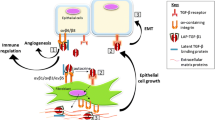Abstract
Hepatocyte growth factor (HGF), a ligand for Met tyrosine kinase, is a mesenchyme- or stroma-derived multipotent factor that regulates the growth, motility, and morphogenesis of various types of cells. During lung development, Met/HGF receptor mRNA was localized in lung epithelial cells, whereas HGF mRNA was localized in lung mesenchymal cells in rat embryos. Antisense HGF oligonucleotides specifically inhibited epithelial branching morphogenesis in cultured lung rudiment isolated from day-13 rat embryos, whereas recombinant HGF stimulated branching morphogenesis. Thus, HGF seems to be at least one of the mesenchyme-derived factors that support branching morphogenesis during lung development. Together with the finding that HGF plays important roles in organogenesis and morphogenesis of organs such as the liver and kidney, HGF seems to be a mediator in epithelium-mesenchyme interactions during organogenesis. Extending the conceptual framework of epithelium-mesenchyme (or epithelium-stroma) interactions, we next examined the possible involvement of HGF in tumor-stroma interactions, because the growth and motility of carcinoma cells are regulated through their interactions with host stromal cells. HGF induced in vitro migration and invasion of GB-d1 gallbladder carcinoma cells into basement membrane components and collagen-gel matrix; however, several other growth factors did not induce marked migration and invasion of the carcinoma cells. GB-d1 cells do not produce HGF, but they produce an inducing factor for HGF production in fibroblasts; the inducing molecule was identified as interleukin 1β. Cocultivation of GB-d1 cells with stromal fibroblasts embedded in a collagen-gel matrix induced invasion of GB-d1 cells into the collagen gels, but invasion was inhibited by a specific antibody against HGF. This indicates that in vitro invasion of GB-d1 cells depends on stromal fibroblasts and that the fibroblast-derived invasion factor is HGF. Since HGF stimulated in vitro migration and invasion of various carcinoma cells and several carcinoma cells produced inducing factors for HGF production in stromal fibroblasts, the looped interaction of carcinoma cells and stromal fibroblasts mediated by HGF and HGF inducers may be a mechanism responsible for acquisition of the malignant phenotype through tumor-stroma interactions.
Similar content being viewed by others
Author information
Authors and Affiliations
Rights and permissions
About this article
Cite this article
Matsumoto, K., Date, K., Ohmichi, H. et al. Hepatocyte growth factor in lung morphogenesis and tumor invasion: role as a mediator in epithelium-mesenchyme and tumor-stroma interactions. Cancer Chemother Pharmacol 38 (Suppl 1), S42–S47 (1996). https://doi.org/10.1007/s002800051037
Issue Date:
DOI: https://doi.org/10.1007/s002800051037




